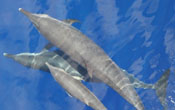Atlantic Spotted Dolphin (Stenella frontalis)
Status | Taxonomy | Species Description | Habitat | Distribution |
Population Trends | Threats | Conservation Efforts | Regulatory Overview |
Key Documents | More Info
Status
MMPA - Atlantic spotted dolphins, like all marine mammals, are protected under the MMPA.
Taxonomy
Kingdom: Animalia
Phylum: Chordata
Class: Mammalia
Order: Cetacea
Family: Delphinidae
Genus: Stenella
Species: frontalis
The Pantropical spotted dolphin (Stenella attenuata) is another species of spotted dolphin.
Species Description
Atlantic spotted dolphins are members of the delphinid family. They are about 5-7.5 ft (1.6-2.3 m) long and weigh 220-315 lbs (100-143 kg). They have a robust or chunky body with a tall, "falcate" dorsal fin located midway down their back. The rounded "melon" is separated from the moderately long beak by a distinct crease. Their shape is often described as an intermediate between a bottlenose and pantropical spotted dolphin (Shirihai and Jarrett 2006). The coloration and patterns vary with age, lifestage, and geographic location. Calves and immature animals have an unspotted three-part muted coloration pattern consisting of a dark gray cape and lighter flanks with a pale white underside giving it a counter-shading effect. As animals age and mature, they gradually become darker and more heavily spotted, especially on the dorsal area.
Atlantic spotted dolphins are usually found in groups of fewer than 50 individuals, but have been occasionally seen in larger groups of around 200 animals. The inshore/coastal pods usually consist of 5-15 animals. Within these social groups, which are composed of a fluid structure, animals may be organized by age and/or sex. Atlantic spotted dolphins are sometimes associated with other cetacean species such as bottlenose dolphins.
The swimming behavior of Atlantic spotted dolphins is often described as acrobatic due to their frequent "breaching", jumping, and other aerial activities at the surface. They are capable of swimming at very fast speeds and often approach vessels to "bowride".
Atlantic spotted dolphins generally make dives of about 30 ft (10 m) or less for 2-6 minutes, but are capable of reaching depths of 130-200 ft (40-60 m) and have been recorded holding their breath for up to 10 minutes. During dives they feed on small fish, benthic invertebrates, and cephalopods (e.g., squid and octopus). They have 30-42 pairs of small conical teeth in each jaw that are useful for grasping prey. Groups will often coordinate their movements to cooperatively feed on prey. Individuals have also been observed using their beaks to dig into sand on the ocean bottom to capture and feed on hiding fish.
Atlantic spotted dolphins become sexually mature and begin breeding between 8-15 years of age. Females give birth to a single calf that is about 2.5-4 ft (0.8-1.2 m) long every 1-5 years (average of 3 years). Mothers may nurse calves for 1-5 years. The estimated lifespan of this species is unknown.
Habitat
Atlantic spotted dolphins prefer the tropical to warm temperate waters along the continental shelf of the Atlantic Ocean. This species generally occurs in coastal or continental shelf waters 65-820 ft (20-250 m) deep, but can be found occasionally in deeper oceanic waters.
Distribution
Atlantic spotted dolphins occur throughout the warm temperate, subtropical, and tropical waters of the Atlantic Ocean. They have a widespread distribution that ranges from the U.S. East Coast (Gulf of Mexico to Cape Cod, MA), the Azores and Canary Islands, to Gabon, and Brazil. A long-term resident population is well known in the sand flats of the Bahamas. Their distribution may be affected by warm currents such as the Gulf Stream.
Population Trends
For management purposes, Atlantic spotted dolphins inhabiting U.S. waters have been divided into two stocks: the Northern Gulf of Mexico Stock and the Western North Atlantic Stock. The northern Gulf of Mexico stock is estimated at 24,500-31,000 animals, while the population in the western North Atlantic is estimated at 36,000-51,000 animals. There are insufficient data available on current population trends.
Threats
Atlantic spotted dolphins have been incidentally taken as bycatch in fisheries such as gillnets and purse seines. This species has been observed interacting with various fishing vessels, often following and feeding on discarded catch. A few animals have been harpooned in the Caribbean, South America (e.g., Brazil), West Africa, and other offshore islands for food and bait.
Conservation Efforts
The International Union for Conservation of Nature and Natural Resources (IUCN's) Red List of Threatened Species ![]() considers this species to be "Data Deficient" due to insufficient information on population status and trends.
considers this species to be "Data Deficient" due to insufficient information on population status and trends.
Regulatory Overview
This species is protected under the Marine Mammal Protection Act of 1972 as amended.
Key Documents
(All documents are in PDF format.)
| Title | Federal Register | Date |
|---|---|---|
| Stock Assessment Reports | n/a | various |
References:
- Jefferson, T. A, M. A. Webber, and R. L. Pitman. (2008). Marine Mammals of the World, A Comprehensive Guide to their Identification. Amsterdam, Elsevier. p. 228-231.
- Shirihai, H. and B. Jarrett (2006). Whales, Dolphins and Other Marine Mammals of the World. Princeton, Princeton University Press. p. 192-194.
